|
|
 |
During normal VST/OmegaCAM operations standard star frames (DPR.TYPE = STD,ZEROPOINT) are taken on the same night matching each filter for which science data was obtained. The data consists of a single standard star field of similar airmass and identical filter. To monitor the ambient conditions (extinction) another standard star observation is made of the polar field (DPR.TYPE = STD,EXTINCTION) at the beginning, middle, and end of the night.
The standard frame is bias corrected, flat-fielded, background subtracted, and trimmed. SExtractor is run on the image and is cross-matched to sources present in the external standard star catalogue (REFERENCE_STAR_CATALOG). The apparent magnitudes of the SExtractor catalogue and the absolute magnitudes of the REFERENCE_STAR_CATALOG is used to define the zeropoints for each detector. The zeropoints monitored for the health check plots are derived from flux units of electrons/second.
The pipeline creates four output frames from its standard star recipe (omega_standard_star): a reduced standard star image (OC_PSTD_<date>_1_1_normal_normal_<filter>.fits), a photometric fits table listing each secondary standard star source detected in each detector (OC_PPHO_<date>_1_1_normal_normal_<filter>.fits), a fits table listing the computed zeropoints for each detector (OC_PZPT_<date>_1_1_normal_normal_<filter>.fits), and a mask of bad pixels, saturated pixels, and satellite trails for the reduced standard star image (OC_PSMA_<date>_1_1_normal_normal_<filter>.fits).
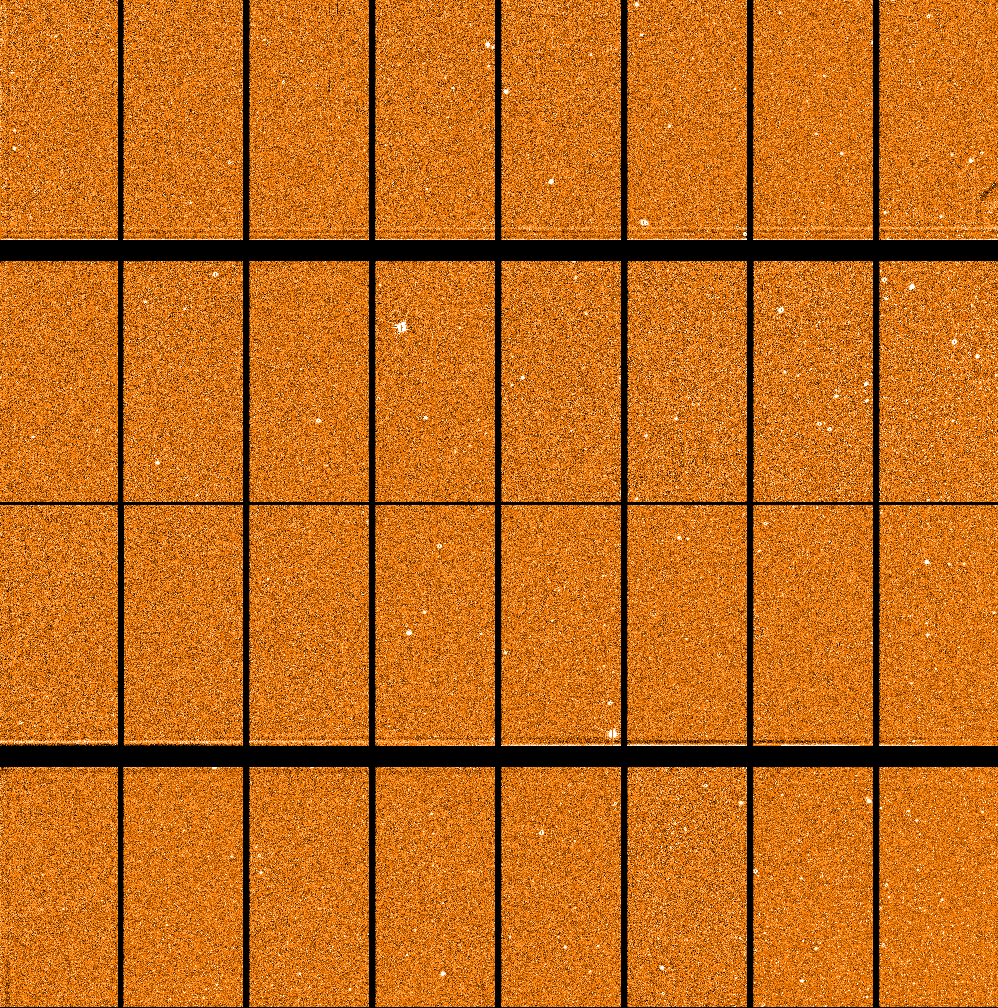 |
The full OmegaCAM reduced standard frame (r_SDSS filter). |
 |
A single detector (ESO_CCD_#71) OmegaCAM reduced standard frame (r_SDSS filter).
|
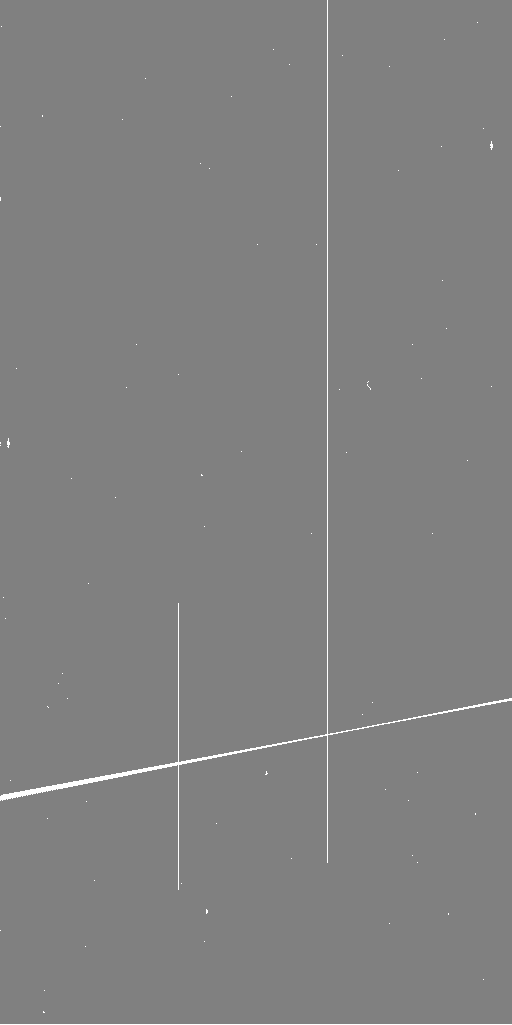 |
A single detector (ESO_CCD_#71) OmegaCAM reduced standard mask (r_SDSS filter). A value of 1 indicates a bad pixel; otherwise 0. |
top
STD parameters trended
|
QC1 Health Check Plots
The QC1 health check plots for the OmegaCAM standard stars consist of monitoring the zeropoints for each of the following filter sets: u_SDSS, g_SDSS, r_SDSS, i_SDSS, z_SDSS, B_JOHN, and V_JOHN. In each case, the average zeropoint, its rms, and the zeropoints of the individual detectors are monitored.
Furthermore, the standard stars contribute to a monitoring of the image quality via a measure of the image FWHM vs. the corrected (corrected for waveband and airmass) DIMM seeing values and the ellipticity values measured for stellar sources. These are plotted for the standard Sloan bands (u_SDSS, g_SDSS, r_SDSS, i_SDSS, and z_SDSS).
Zeropoints:
- for each of the filters: u_SDSS, g_SDSS, r_SDSS, i_SDSS, z_SDSS, B_JOHN, and V_JOHN:
- zeropoint as averaged over all 32 detectors
- zeropoint rms averaged over all 32 detectors
- zeropoints for each individual detector
- score outliers
Image Quality:
- for each of the filters: u_SDSS, g_SDSS, r_SDSS, i_SDSS, and z_SDSS:
- image quality plotting the stellar source FWHM vs. the corrected (for airmass and waveband) DIMM seeing (arcsec)
- the difference in the standard star FWHM vs. the corrected DIMM seeing (arcsec)
- score outliers
- for each of the filters: u_SDSS, g_SDSS, r_SDSS, i_SDSS, and z_SDSS:
- the stellar source ellipticity (1 - b/a) averaged over all 32 detectors
- the stellar source ellipticity rms averaged over all 32 detectors
- the stellar source ellipticity for each individual detector
- score outliers
QC1 parameters (trended for each individual detector)
| Parameter |
Table: Name (QC1 database) |
Description of Procedure |
| detector zeropoint (ADU/sec) |
omegacam_std: qc.zeropoint |
The detector zeropoint derived from flux units of ADU/second. |
error in the detector zeropoint (ADU/sec)
|
omegacam_std: qc.zeropoint.err |
The error in the detector zeropoint derived from flux units of ADU/second. |
| detector zeropoint (e-/sec) |
omegacam_std: qc.zeropoint.electron |
The detector-specific zeropoint computed from flux units of electrons/second. This zeropoint is the one used for all OmegaCAM standard star zeropoint health check plots. |
| error in the detector zeropoint (e-/sec) |
omegacam_std: qc.zeropoint.electron.err |
The error in the detector-specific zeropoints computed from flux units of electrons/second. |
| number of standard stars |
omegacam_std: qc.std.number.stars |
The number of stars found both in the SExtractor catalogue created from the frame itself and the REFERENCE_STAR_CATALOG. Thus, only for a standard star frame that overlaps with the polar or equatorial standard star fields will provide zeropoints. |
| extinction |
omegacam_std: qc.extinction |
The extinction used for the detector. If the standard is STD,EXTINCTION then the extinction is computed from the frame itself using: ext = -(mag - mag0)/airmass. |
| error in the extinction |
omegacam_std: qc.extinction.err |
The error in the detector extinction. |
| standard star matches with USNO-A2 |
omegacam_std: qc.std.matches |
The astrometry of the standard star frame is computed using the USNO-A2 catalogue (the input is the MASTER_USNOA2_CATALOGUE). The number of matches between USNO-A2 stars in this catalogue and those detected in the frame itself (SExtractor pass) is given by this parameter. The ratio of matches between USNO-A2 catalogue and the stars detected in CCD is given by the related parameter qc_std_ratio_matches. |
| standard star FWHM |
omegacam_std: qc.std.seeing |
The median SExtractor catalogue FWHM of detected sources having STAR_CLASS>=0.9 (arcsec). |
| standard star ellipticity |
omegacam_std: qc.std.ellipticity |
The median SExtractor catalogue ellipticity (1 - B/A) of detected sources having STAR_CLASS>=0.9. |
| average airmass of standard star |
omegacam_std: qc.airmass |
The average airmass measured during the exposure (start + end)/2. |
| average DIMM seeing |
omegacam_std: qc.ambi.seeing |
The average DIMM seeing after correcting it for the central wavelength and airmass of the observation (arcsec). |
| average temperature of the two detector plate probes |
omegacam_std: qc.temp.mosaic.plate |
The average value of the header temperature keyword DET.TLM5 and DET.TLM8, both of which probe the temperature of the mosaic plate (Kelvin). |
QC Reports for the standard star frames
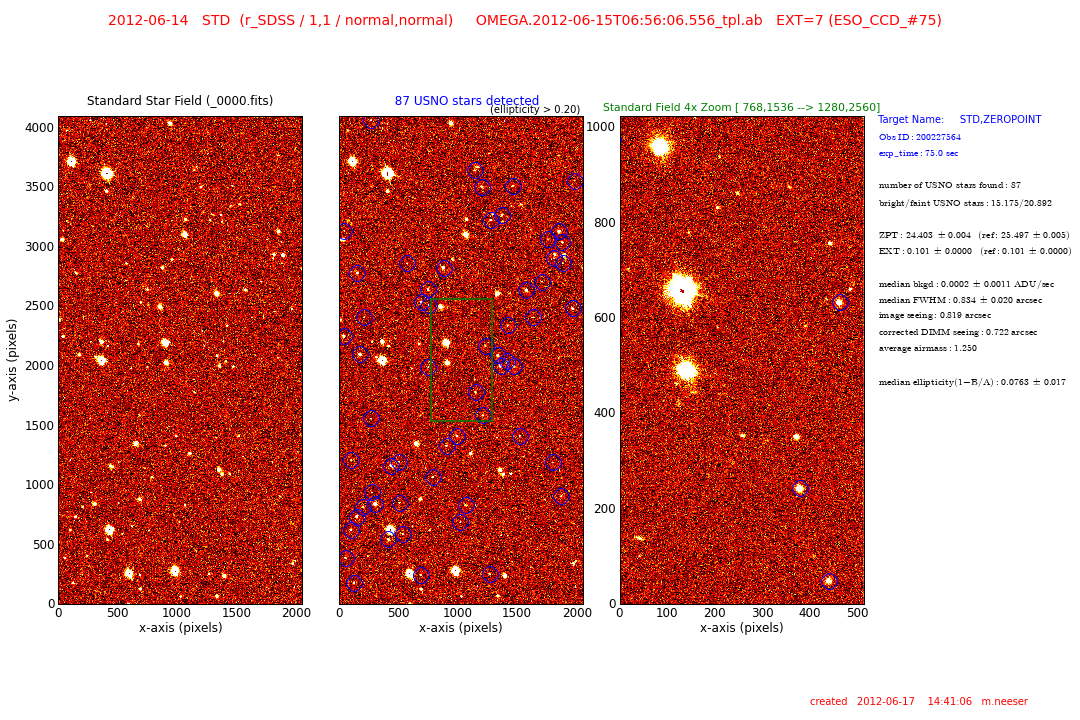
QC Report 1:
left: full-field image of the reduced standard star field of the extension listed at the top of the image
center: full-field image of the reduced standard star field with detected USNO-A2 stars marked with blue circles. If the USNO-A2 star has an ellipticity >= 0.20 the marking circle is black.
right: a 4x zoom of the center area of the reduced standard star field. At the far right of these images, a number of data parameters are listed.
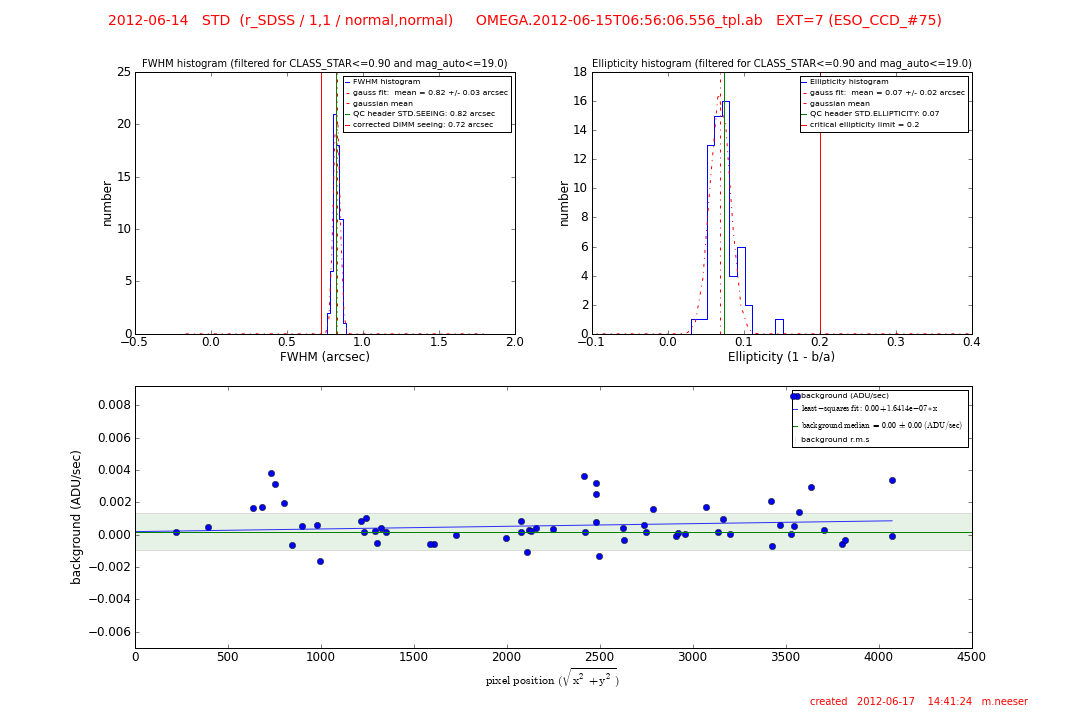
QC Report 2:
top left: A histogram of the FWHM measured for all detected sources having CLASS_STAR <= 0.90 and mag_auto <= 19.0.
A Gaussian fit to the FWHM histogram is shown (dotted red line) and its values indicated in the legend. The QC header STD.SEEING is shown as a vertical green line and the corrected DIMM seeing (corrected to the wavelength of the STD observation and the airmass) is shown as a vertical red line.
top right: A histogram of the ellipticity (1 - B/A) measured for all detected sources having CLASS_STAR <= 0.90 and mag_auto <= 19.0.
A Gaussian fit to the ellipticity histogram is shown (dotted red line) and its values indicated in the legend. The QC header STD.ELLIPTICITY is shown as a vertical green line and the critical ellipticity limit of 0.20 is marked as a red vertical line.
bottom: The background level (in ADU) measured around each detected source as a function of its radial position from the bottom left-hand corner of the image. A least-square fit to the radial dependence of the background and the background median is given in the legend.
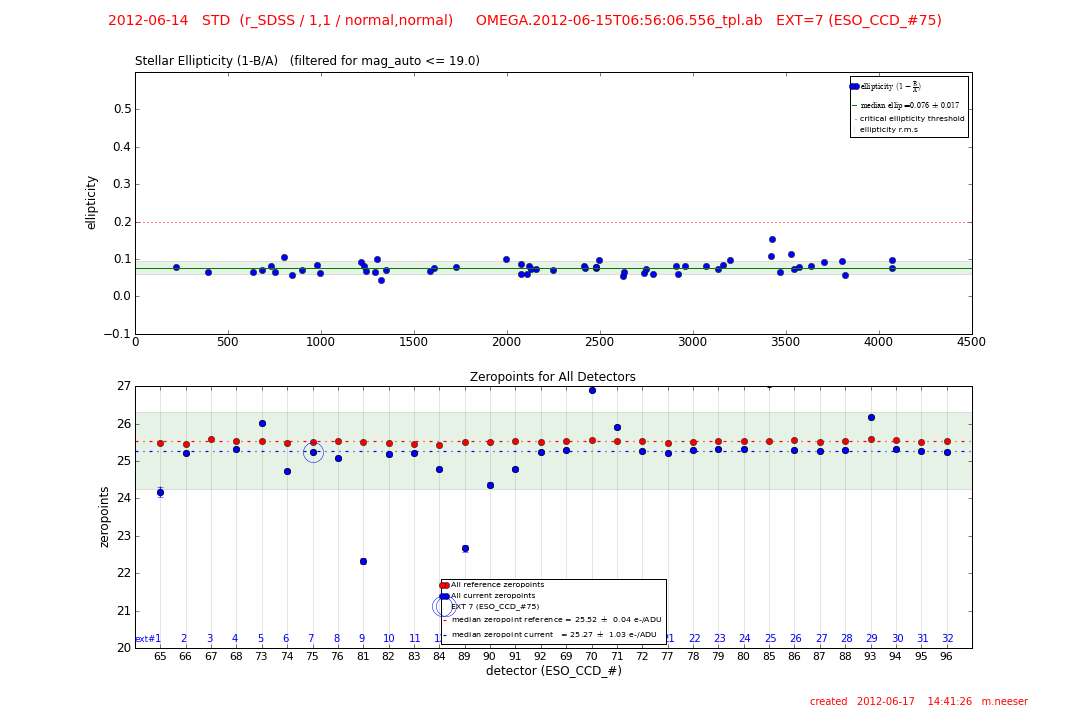
QC Report 3:
top: The ellipticity (1 - B/A) of each detected source as a function of its radial position from the bottom left-hand corner of the image. The median ellipticity is shown as a green line and is given in the legend. The critical ellipticity limit of 0.20 is marked as a red dotted line.
bottom: for ALL detectors the zeropoints are plotted for both the current standard star field (blue points) and the reference standard field (red points). The zeropoint of the current detector viewed in the other QC reports is marked with a circle. The median zeropoint of all detectors is shown as a blue (current) and red (reference) dotted line and is listed in the legend. The shaded green area is the +/- 1sigma scatter of the current zeropoints.
Trending and Issues
The input standard star reference catalogue for the equatorial and polar fields (REFERENCE_STAR_CATALOG => OC_GSTD_111125_ALL.fits) is not yet complete. As a result, some star fields will lie outside of the standard star coverage and will not be able to provide zeropoints. This is particularly true of the polar field which is currently not included in the catalogue. This will improve as the VST/OmegaCAM coverage matures.
History
|
![[ ESO ]](/images/eso-logo.gif)
![[ ESO ]](/images/eso-logo.gif)
